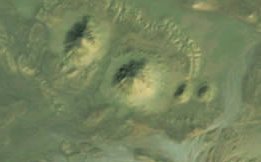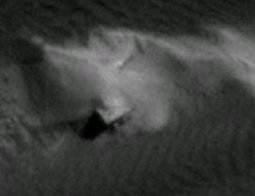
In the year 1976 the Viking orbiter took some images of the Cydonia (Mensae) region on Mars which showed a huge humanoid "face" which was approximately 3.6 miles long. NASA's official explanation was that the face is nothing more than a trick of light. Later images however revealed certain curiousities dat could mean that it still may have been artificially made. Whether it would really represent a face would be yet another question.
|
|
|
On the newer higher resolution photos by the Mars Global Surveyor (MGS) it looks like the facial features aren't as strongly present as seen on the earlier photos before and some took it as proof that it is nothing more than a natural shaped mensa. However, we should not forget that there are raging heavy sandstorms on the surface of Mars and because of this, this "face" would also be buried below a thick layer of sand, and what something that would lay below a thick layer of sand would always look "natural". Because the remarkable symmetry of the mensa and the smooth looking, steep outlines it has the impression of being artificially carved and also nothing in its direct surroundings shows the same kind of characteristics. Although it seems unlikely, if it indeed was carved into a face, it would seem that the left side (shown right on the image) would be caved in or heavily damaged, possibly due to erosion or the impact of meteors. If one looks really close one could notices details below the sand which look like the pupil of an eye and a nostril, although this nostril is clearly an impact crater.
|
|
|
In the local neighbouring of the "face" there are also more formations which are also so far buried with sand that only the outlines are visible. Many of these formations show such sharp angles that these do not seem to have been naturally shaped, and because of their shape they are similar to the pyramids as of earth, but especially with less or more sides. One of these "pyramids" is informally known as the "D&M pyramid" (seen below), which had been named after its discoverers Vincent Di Pietro and Gregory Molenaar, who were both NASA computer engineers and believed that the "face" was made by an ancient civilization.
Also on other places on Mars there are this kind of formations and also those that initially seem to be mensa like the "face". It could be that these are all artificial formations, which would mean that there would be structures all over Mars, layered with metres of sand and awaiting their discovery.
|
|
 At
the image shown here on the right
there is a supposedly but currently not yet excavated pyramid complex
in
Egypt, which had been discovered in August of the year 2012 from
Google Earth's satellite images by researcher and satellite
archaeologist Angela Micol from Nord-Carolina. (Image credit:
Angela Micol.) Some time after the discovery it was revealed that the
location is the site of Abu Sidhum in the Sahara desert. Because these
supposed pyramids are possibly buried by sand storms, they look
somewhat similar to these pyramidal formations on Mars.
At
the image shown here on the right
there is a supposedly but currently not yet excavated pyramid complex
in
Egypt, which had been discovered in August of the year 2012 from
Google Earth's satellite images by researcher and satellite
archaeologist Angela Micol from Nord-Carolina. (Image credit:
Angela Micol.) Some time after the discovery it was revealed that the
location is the site of Abu Sidhum in the Sahara desert. Because these
supposed pyramids are possibly buried by sand storms, they look
somewhat similar to these pyramidal formations on Mars.
There could be a possible connection between Egypt and Mars; The place Giza, where the three great pyramids are standing, borders to the place Cairo: the capital of Egypt. In ancient times Caïro was the name for the Greek god Aries, later known as Mars by the Romans. He originally was the god of agriculture before he became the god of war. In the Arabic language the place Caïro is known as "Al Qahiri", which also means "Mars". Why did the ancient Egyptians named this city after Mars?
 There are many more
strange formations on Mars that are more or less unexplained by current
science. During December of the year 2010, another
curious formation on Mars had been found on Google's map of Mars. It is
situated to the east of the Moreux Crater and can be found by the
coordinates: 41 57'46.61N 44 43'35.11E. (See image on the left. Click here for a larger image.)
There are many more
strange formations on Mars that are more or less unexplained by current
science. During December of the year 2010, another
curious formation on Mars had been found on Google's map of Mars. It is
situated to the east of the Moreux Crater and can be found by the
coordinates: 41 57'46.61N 44 43'35.11E. (See image on the left. Click here for a larger image.)
It seems a rectangular formation, possibly a kind of
plateau or roof, with sharp edges at 90 degrees, which do not or rarely
are formed by nature. This formation might be a building that is
covered for the largest part by sand. (Discovered by "TheFIX2010"; a
forum member of godlikeproductions.com.)



